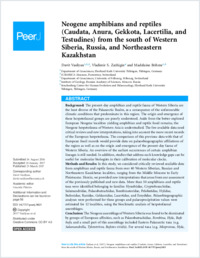Neogene amphibians and reptiles (Caudata, Anura, Gekkota, Lacertilia, and Testudines) from the south of Western Siberia, Russia, and Northeastern Kazakhstan
- Vasilyan, Davit Department of Geosciences, Eberhard Karls University Tu¨bingen, Tuebingen, Germany - JURASSICA Museum, Porrentruy, Switzerland - Department of Geosciences, University of Fribourg, Switzerland
- Zazhigin, Vladimir S. Institute of Geology, Russian Academy of Sciences, Moscow, Russia
- Böhme, Madelaine Department of Geosciences, Eberhard Karls University Tu¨bingen, Tu¨bingen, Germany - Senckenberg Center for Human Evolution and Palaeoecology, Eberhard Karls University, Tuebingen, Germany
-
23.03.2017
Published in:
- PeerJ. - 2017, vol. 5, p. e3025
English
The present-day amphibian and reptile fauna of Western Siberia are the least diverse of the Palaearctic Realm, as a consequence of the unfavourable climatic conditions that predominate in this region. The origin and emergence of these herpetofaunal groups are poorly understood. Aside from the better-explored European Neogene localities yielding amphibian and reptile fossil remains, the Neogene herpetofauna of Western Asia is understudied. The few available data need critical reviews and new interpretations, taking into account the more recent records of the European herpetofauna. The comparison of this previous data with that of European fossil records would provide data on palaeobiogeographic affiliations of the region as well as on the origin and emergence of the present-day fauna of Western Siberia. An overview of the earliest occurrences of certain amphibian lineages is still needed. In addition, studies that address such knowledge gaps can be useful for molecular biologists in their calibration of molecular clocks.Methods and Results: In this study, we considered critically reviewed available data from amphibian and reptile fauna from over 40 Western Siberian, Russian and Northeastern Kazakhstan localities, ranging from the Middle Miocene to Early Pleistocene. Herein, we provided new interpretations that arose from our assessment of the previously published and new data. More than 50 amphibians and reptile taxa were identified belonging to families Hynobiidae, Cryptobranchidae, Salamandridae, Palaeobatrachidae, Bombinatoridae, Pelobatidae, Hylidae, Bufonidae, Ranidae, Gekkonidae, Lacertidae, and Emydidae. Palaeobiogeographic analyses were performed for these groups and palaeoprecipitation values were estimated for 12 localities, using the bioclimatic analysis of herpetofaunal assemblages.Conclusion: The Neogene assemblage of Western Siberia was found to be dominated by groups of European affinities, such as Palaeobatrachidae, Bombina, Hyla, Bufo bufo, and a small part of this assemblage included Eastern Palaearctic taxa (e.g. Salamandrella, Tylototriton, Bufotes viridis). For several taxa (e.g. Mioproteus, Hyla, Bombina, Rana temporaria), the Western Siberian occurrences represented their most eastern Eurasian records. The most diverse collection of fossil remains was found in the Middle Miocene. Less diversity has been registered towards the Early Pleistocene, potentially due to the progressive cooling of the climate in the Northern Hemisphere. The results of our study showed higher- amplitude changes of precipitation development in Western Siberia from the Early Miocene to the Pliocene, than previously assumed.
- Faculty
- Faculté des sciences et de médecine
- Department
- Département de Géosciences
- Language
-
- English
- Classification
- Palaeontology
- License
-
License undefined
- Identifiers
-
- RERO DOC 288669
- DOI 10.7717/peerj.3025
- Persistent URL
- https://folia.unifr.ch/unifr/documents/305408
Statistics
Document views: 112
File downloads:
- pdf: 201
